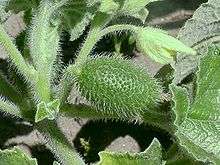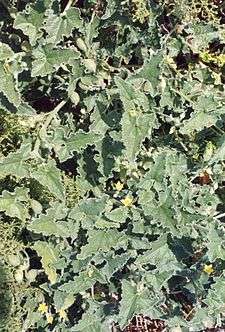Ecballium
Ecballium is a genus of flowering plants in the family Cucurbitaceae containing a single species, Ecballium elaterium,[1] also called the squirting cucumber or exploding cucumber (but not to be confused with Cyclanthera brachystachya). It gets its unusual name from the fact that, when ripe, it squirts a stream of mucilaginous liquid containing its seeds, which can be seen with the naked eye. It is thus considered to have rapid plant movement.
| Squirting cucumber | |
|---|---|
 | |
| A fruit of the squirting cucumber | |
| Scientific classification | |
| Kingdom: | Plantae |
| Clade: | Tracheophytes |
| Clade: | Angiosperms |
| Clade: | Eudicots |
| Clade: | Rosids |
| Order: | Cucurbitales |
| Family: | Cucurbitaceae |
| Subfamily: | Cucurbitoideae |
| Tribe: | Bryonieae |
| Genus: | Ecballium A.Rich.[1] |
| Species: | E. elaterium |
| Binomial name | |
| Ecballium elaterium | |
| Synonyms | |
|
Elaterium Mill. | |
The tissue in the fruit of the Ecballium elaterium that surrounds the seed is thin walled. The pressure to release the seed is created by the increased concentration of glucoside and elaterinidin in low volumes of cytoplasm. This creates an osmotic pressure of up to 27 atms.[2] The pressure building method also seems to rely on the phloem sieve tubes. This also means that the shooting mechanism can be decreased in water stressed conditions.[3]
The fruit also utilizes hygroscopic movement in order to shoot the seeds out of the fruit. This method is done passively where the fruit changes its structure when it dies and tension is relieved in the dead tissue, causing movement. This movement can be due to coiling, bending, or twisting cells that increases its morphological shape as the cell dries. Because dying cells are mostly made up of cell wall, the shape will be determined by the shape of the cell wall. This is a method of self-dispersal.[4]
Sudden movements in plant tissues are prone to different types of mechanical instabilities. In the case of E. elaterium, due to the relationship between the duration of movement and the size of the tissue, the plant tissue fractures.[5]
Effectiveness of the dispersal seems to be low as a study found that even though the E. elaterium could have sprayed its seed to the whole plot, the size and location of the infested areas remained relatively similar.[6]
It is native to Europe, northern Africa, and temperate areas of Asia.[7] It is grown as an ornamental plant elsewhere, and in some places it has naturalized.[7][8]
It is suspected to provide food for the caterpillars of the tortrix moth Phtheochroa rugosana.
This plant, and especially its fruit, is poisonous, containing cucurbitacins.[9] In the ancient world it was considered to be an abortifacient.[10]

Elaterium
Elaterium is the plant extract used as a purgative. It is extracted from the juice of the fruit of Ecballium elaterium. It was discovered by Dr J. D. M. Stirling in 1835.[11]
To prepare the extract, the fruit is sliced lengthwise and slightly pressed, the greenish and slightly turbid juice obtained is strained and set aside, and the deposit of elaterium formed after a few hours is collected on a linen filter, rapidly drained, and dried on porous tiles at a gentle heat. Elaterium has been produced in light, thin, friable, flat or slightly incurved opaque cakes, of a greyish-green color, bitter taste and tea-like smell. The extract is soluble in ethanol, but insoluble in water and diethyl ether. The official dose used to be 1 1⁄2 grain, and the British pharmacopeia at the beginning of the 20th century directs that the drug is to contain from 20 to 25% of the active principle elaterinum or elaterin. A resin in the natural product aids its action.[12]
Elaterin is extracted from elaterium by chloroform and then precipitated by ether. It has the formula C32H44O7. It forms colorless scales which have a bitter taste, but it is highly inadvisable to taste either this substance or elaterium. The British pharmacopeia contained a useful preparation, the Pulvis Elaterini Compositus, which contains one part of the active principle in 40.[12]
According to the Encyclopædia Britannica Eleventh Edition, "[t]he action of this extract resembles that of the saline aperients, but is much more powerful. It is the most active hydragogue purgative known, 'causing also much depression and violent griping'. When injected subcutaneously it is inert, as its action is entirely dependent upon its admixture with the bile. The drug is undoubtedly valuable in cases of dropsy and Bright's disease, and also in cases of cerebral haemorrhage, threatened or present. It must not be used except in urgent cases, and must invariably be employed with the utmost care, especially if the state of the heart be unsatisfactory."[12] Some of these contemporaneous statements are now outdated.
References
| Wikimedia Commons has media related to Ecballium elaterium. |
- "Search results for Ecballium". The Plant List. Retrieved 1 March 2016.
- Kozlowski, T.T. (1972). Seed Biology: Importance, Development, and Germination, Volume 1. Academic Press. pp. 175, 196–197. ISBN 9780323150675.
- Sheikholeslam, Shahla N.; Currier, Herbert B. (1977-03-01). "Effect of Water Stress on Turgor Differences and 14C-Assimilate Movement in Phloem of Ecballium elaterium". Plant Physiology. 59 (3): 381–383. doi:10.1104/pp.59.3.381. ISSN 0032-0889. PMID 16659856.
- Elbaum, Rivka; Abraham, Yael (2014-06-01). "Insights into the microstructures of hygroscopic movement in plant seed dispersal". Plant Science. 223: 124–133. doi:10.1016/j.plantsci.2014.03.014. ISSN 0168-9452.
- Forterre, Y.; Marmottant, P.; Quilliet, C.; Noblin, X. (2016-01-01). "Physics of rapid movements in plants". Europhysics News. 47 (1): 27–30. doi:10.1051/epn/2016104. ISSN 0531-7479.
- Blank, Lior; Birger, Nitzan; Eizenberg, Hanan (November 2019). "Spatial and Temporal Distribution of Ecballium elaterium in Almond Orchards". Agronomy. 9 (11): 751. doi:10.3390/agronomy9110751.
- "Ecballium elaterium". Germplasm Resources Information Network (GRIN). Agricultural Research Service (ARS), United States Department of Agriculture (USDA). Retrieved 21 December 2017.
- "Ecballium elaterium (L.) A. Rich". USDA PLANTS.
- Attard, E. G.; Scicluna-Spiteri, A (2001). "Ecballium elaterium: An in vitro source of cucurbitacins". Fitoterapia. 72 (1): 46–53. doi:10.1016/s0367-326x(00)00256-2. PMID 11163940.
- Pliny Naturalis historia, Book XX, 4
- Biographical Index of Former Fellows of the Royal Society of Edinburgh 1783–2002 (PDF). The Royal Society of Edinburgh. July 2006. ISBN 0-902-198-84-X.
- Chisholm 1911.
